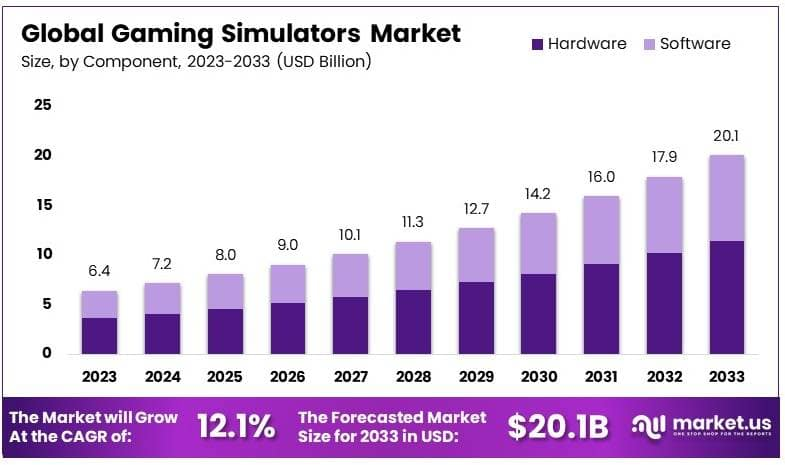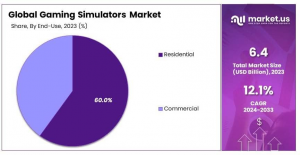
Gaming Simulators Market to Reach USD 20.1 Billion by 2033, with Gaming Innovations Driving 12.1% CAGR

Gaming Simulators Market Size
Gaming Simulators Market size is expected to be worth around USD 20.1 Bn by 2033, from USD 6.4 Bn in 2023, growing at a CAGR of 12.1% during forecast period.
NEW YORK, NY, UNITED STATES, January 29, 2025 /EINPresswire.com/ -- Report Overview
According to the report by Market.us, the global gaming simulators market size is anticipated to grow significantly, reaching approximately USD 20.1 billion by 2033, up from USD 6.4 billion in 2023, marking a Compound Annual Growth Rate (CAGR) of 12.1% during the forecast period from 2024 to 2033.
Gaming simulators are advanced devices or software that replicate real-life environments, enabling users to engage in immersive and realistic gaming experiences. These simulators can range from flight simulators and racing games to virtual sports, providing high levels of realism that enhance the overall user experience. The market's growth is driven by the increasing popularity of e-sports, the advancement of virtual reality (VR) and augmented reality (AR) technologies, and the growing demand for interactive and immersive gaming experiences.
The surge in online gaming platforms and competitive gaming leagues has also propelled the need for high-quality gaming simulators, particularly in the racing and professional training sectors. As new technologies, including AI and VR, continue to evolve, the market for gaming simulators is expected to expand in both residential and commercial sectors.
The report highlights key trends, such as the rise of subscription-based models and multi-user simulator experiences, alongside regional dynamics where North America leads the market, followed closely by Asia-Pacific and Europe. However, challenges such as the high cost of hardware, limited access to advanced technologies in developing regions, and competition from traditional gaming consoles remain substantial hurdles for market growth.
🔴 𝗪𝗮𝗻𝘁 𝗗𝗲𝗲𝗽𝗲𝗿 𝗜𝗻𝘀𝗶𝗴𝗵𝘁𝘀? 𝗘𝘅𝗽𝗹𝗼𝗿𝗲 𝗢𝘂𝗿 𝗥𝗲𝗽𝗼𝗿𝘁 𝗦𝗮𝗺𝗽𝗹𝗲𝘀 𝗮𝗻𝗱 𝗧𝗮𝗸𝗲 𝗔𝗰𝘁𝗶𝗼𝗻 𝗧𝗼𝗱𝗮𝘆 - https://market.us/report/gaming-simulators-market/request-sample/
Key Takeaways
- The global gaming simulators market is projected to reach USD 20.1 billion by 2033, growing at a CAGR of 12.1% from 2024 to 2033.
- The hardware segment leads the market with 57% share in 2023, driven by strong demand for immersive and professional-grade setups.
- Racing simulators dominate the market with 48% share due to their wide appeal and competitive nature in gaming.
- The residential end-use sector held the largest market share in 2023, at 60%, highlighting a growing trend of home-based gaming setups.
- North America commands the largest regional market share, contributing USD 2.3 billion in 2023, supported by technological advancements and a large consumer base.
Regional Analysis
North America holds the dominant share of the global gaming simulators market, representing 36% of the market, or USD 2.3 billion, in 2023. This region benefits from its robust technological infrastructure, high consumer spending on entertainment, and the widespread adoption of advanced gaming technologies like VR and AR.
North America also leads due to its strong e-sports culture, significant gaming community, and the ongoing development of high-end simulators. As the demand for competitive gaming and immersive experiences continues to rise, the region is expected to maintain its dominant position in the coming years. Other regions like Asia-Pacific and Europe are also experiencing rapid growth driven by increasing interest in gaming and e-sports, with a strong focus on developing next-gen technologies.
Report Segmentation
By Component
The market is split between hardware and software, with hardware holding the larger share of 57% in 2023. The demand for high-quality hardware such as steering wheels, VR headsets, and racing seats is driving this segment's growth. The software segment, although smaller, plays a vital role in providing the interactive gaming environment, supporting AI integration and realistic graphics, which are critical for enhancing user experience. Both segments are crucial for creating the immersive gaming experiences that users demand.
By Game Type
Racing simulators are the most popular category, holding 48% of the market share in 2023. These simulators provide high-adrenaline and realistic driving experiences, attracting both casual gamers and competitive e-sports players. The growing popularity of professional gaming leagues in racing contributes to this segment's expansion. While smaller segments like fighting and shooting simulators continue to grow, racing remains the leader due to its wide appeal across different user demographics.
By End-Use
In 2023, the residential segment dominated the gaming simulators market with 60% of the share. As more gamers invest in personalized, high-performance home setups, this segment is poised for further growth. The commercial segment, although smaller, is steadily growing as gaming centers and e-sports venues continue to flourish, offering advanced simulators for both casual gamers and professionals. As the popularity of gaming lounges and competitive gaming hubs increases, the commercial sector will continue to contribute to market growth.
🔴 𝗣𝘂𝗿𝗰𝗵𝗮𝘀𝗲 𝘁𝗵𝗲 𝗖𝗼𝗺𝗽𝗹𝗲𝘁𝗲 𝗥𝗲𝗽𝗼𝗿𝘁 𝗡𝗼𝘄 𝘄𝗶𝘁𝗵 𝘂𝗽 𝘁𝗼 𝟯𝟬% 𝗼𝗳𝗳 𝗮𝘁 https://market.us/purchase-report/?report_id=15172
Key Market Segments
By Component
- Hardware
- Software
By Game Type
- Fighting
- Shooting
- Racing
- Other Game Type
By End-Use
- Residential
- Commercial
Driving Factors
The Gaming Simulators Market is experiencing growth due to increasing demand for immersive gaming experiences. Technological advancements in virtual reality (VR), augmented reality (AR), and haptic feedback systems have significantly enhanced the realism of gaming simulations, attracting both professional and recreational gamers. The rise of esports and competitive gaming further boosts market demand, with gamers seeking high-performance, customized setups. Additionally, the growing adoption of gaming simulators in industries like automotive, aviation, and military for training purposes drives expansion. Increasing disposable income, the popularity of gaming as a mainstream entertainment medium, and a young, tech-savvy population also fuel market growth.
Restraining Factors
Despite the rapid growth of the Gaming Simulators Market, several challenges hinder its expansion. The high cost of advanced gaming simulators, particularly those involving VR/AR technologies and specialized hardware, limits their accessibility for budget-conscious consumers. Additionally, the complex setup and maintenance required for high-end simulators can be a barrier for many users. Technical issues like compatibility and the need for high-performance PCs or consoles may also restrict market growth. Moreover, while gaming simulators are popular among enthusiasts, they face competition from traditional gaming methods, limiting their widespread adoption among casual gamers.
🔴 𝗪𝗮𝗻𝘁 𝗗𝗲𝗲𝗽𝗲𝗿 𝗜𝗻𝘀𝗶𝗴𝗵𝘁𝘀? 𝗘𝘅𝗽𝗹𝗼𝗿𝗲 𝗢𝘂𝗿 𝗥𝗲𝗽𝗼𝗿𝘁 𝗦𝗮𝗺𝗽𝗹𝗲𝘀 𝗮𝗻𝗱 𝗧𝗮𝗸𝗲 𝗔𝗰𝘁𝗶𝗼𝗻 𝗧𝗼𝗱𝗮𝘆 - https://market.us/report/gaming-simulators-market/request-sample/
Trending Factors
Several trends are shaping the Gaming Simulators Market. The increasing integration of VR and AR technologies is a significant driver, as it enhances immersion and realism, offering gamers a more lifelike experience. The development of motion simulators, incorporating motion seats and steering wheels for racing and flight simulations, is becoming more common. Additionally, cloud gaming services and subscription models are emerging, making high-end simulators more accessible by reducing hardware requirements. Gamification in non-entertainment sectors like education and training is another growing trend, using gaming simulators to provide engaging, interactive learning experiences for students and professionals.
Investment Opportunities
The Gaming Simulators Market presents multiple investment opportunities, particularly in the development of VR and AR-based simulators that offer an immersive and realistic experience. With the expansion of esports, there are investment prospects in simulators designed for professional training, which can be customized to meet specific needs in racing, aviation, and other sectors. The growing popularity of cloud gaming also provides avenues for investment in software platforms that allow users to access simulators without high-end hardware. Additionally, there is potential in the development of affordable simulators targeting casual gamers, expanding the market’s reach to a broader audience.
Market Companies
The gaming simulators market features a mix of leading companies that are pushing the boundaries of immersive gaming experiences. Key players include 3D Perception, D-BOX Technologies Inc., CXC Simulations, and Vesaro. These companies are focused on integrating cutting-edge technologies such as VR, AI, and motion simulation into their products to cater to both enthusiasts and professional e-sports players. As competition intensifies, these players are emphasizing premium performance and customer satisfaction while innovating in hardware, sensory technologies, and customizable gaming setups.
Key Players
- 3D Perception
- AeonSim
- CKAS Mechatronics Pty Ltd.
- CXC Simulations
- D-BOX Technologies Inc.
- Eleetus
- Hammacher Schlemmer & Company Inc.
- Play seat B.V.
- RSEAT Ltd.
- Vesaro
Conclusion
In conclusion, the Gaming Simulators Market is set for significant growth, driven by technological innovations, increasing consumer interest in immersive gaming, and expanding applications in professional training. Despite challenges such as high costs and technical complexity, the market is supported by emerging trends like VR/AR integration and cloud gaming. Investment opportunities in cutting-edge technologies and accessible, affordable products are abundant. With the continuing evolution of gaming preferences and technology, the market is poised to expand, offering substantial potential for both developers and investors in the coming years.
Lawrence John
Prudour
+91 91308 55334
email us here
Visit us on social media:
Facebook
LinkedIn
Distribution channels: Amusement, Gaming & Casino
Legal Disclaimer:
EIN Presswire provides this news content "as is" without warranty of any kind. We do not accept any responsibility or liability for the accuracy, content, images, videos, licenses, completeness, legality, or reliability of the information contained in this article. If you have any complaints or copyright issues related to this article, kindly contact the author above.
Submit your press release

